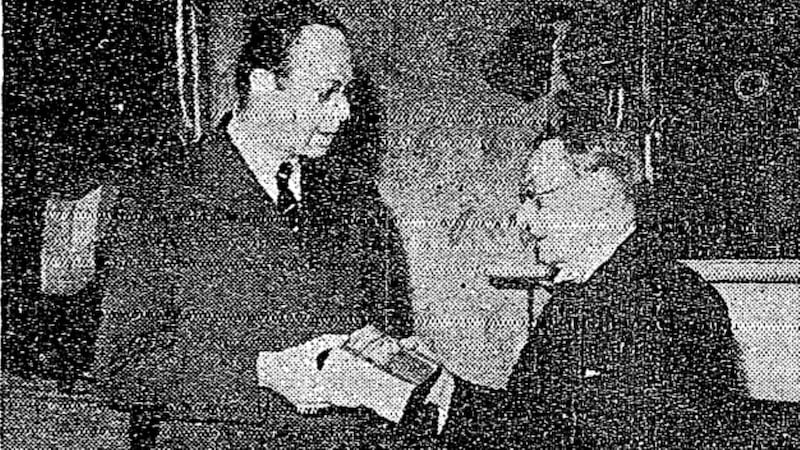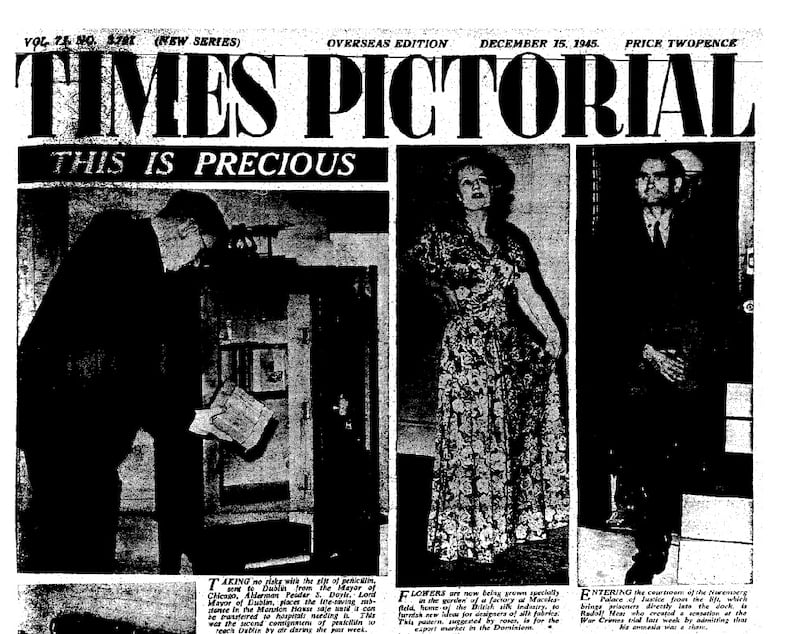The discovery of penicillin instigated one of history’s greatest medical advances, and our archives reveal that Irish scientists, seaweed harvesters, and even de Valera’s daughter, played a role in the development of this life-saving weapon against infection.
Alexander Fleming, a bacteriologist at St Mary's Hospital, London, was replicating the research of three scientists from Trinity College, Dublin when he made his chance discovery in 1928.
An article in 1944 recalled: “He noticed that a blue-green mould had spoiled one of his cultures and had cleared a wide bacteria-free area around itself. Realising that he was on the verge of some tremendous discovery, Dr Fleming stuck a loop of platinum wire into the mould, then dipped it in a test-tube containing mould nutrient. In less than a week a mat of the mould had grown at the mouth of the tube and a half-inch of cloudy liquid had formed below it. When diluted 800 times this liquid prevented staphylococci from growing at all . . . It was the first crude penicillin every produced.”
The crucial element in the Trinity research, published in 1927 by JW Bigger, CR Boland and RAQ O’Meara, was an instruction to culture bacteria at room temperature, instead of incubating them. And in 1946, when Fleming was awarded an honorary degree by the Dublin university, his introduction explained: “It was while he was repeating some experiments originally carried out in our laboratories that he made those discoveries . . . enabling him to confer upon mankind a boon the like of which it has seldom received. Many indeed are they whom Sir Alexander has brought back from the jaws of death.” After the ceremony Fleming was photographed with Bigger, who was leading further research on the antibiotic.
Isolate
However, though Fleming had published his findings in 1929, he was unable to isolate penicillin as a therapeutic compound. This, an article in 1944 noted, was only achieved by scientists at Oxford university in 1939 when "the shadow of World War II loomed, and the need for a good internal and external antiseptic for the treatment of bacteria-infected wounds became imperative." A team led by Prof Howard Florey and Dr Ernest Boris Chain "abandoned all other work to study the practical extraction of penicillin" and soon "had accumulated sufficient of the drug to test it on living creatures".
When pharmaceutical companies in Great Britain were unable to mass-produce penicillin because of war commitments, the scientists turned to the USA, where it was quickly manufactured for military use. Its impact was immediate. According to American sources in June 1944, “thanks largely to the efficacy of the new drug penicillin, less than one per cent of those wounded soldiers who had been treated since the invasion of Normandy had succumbed to their injuries.”

The drug gradually became a feature of civilian treatment too. In July 1944, Churchill announced "that penicillin, which had hitherto been restricted to military use, would now be available for all flying bomb casualties". Also that summer, "penicillin obtained from Northern Ireland military authorities was rushed to Ballymena Cottage Hospital and saved the life of Rex Bonnar, who was suffering from septicaemia, which had refused to respond to other treatment."
The drug was now “claimed as effective in the treatment of syphilis, gonorrhea, pneumococcus meningitis, cerebro-spinal meningitis; eye, nose and throat complications; bacterial endo-carditis; cellulitis; myocarditis; osteomylitis (inflammation of the bone marrow), ulcers; burns and infected wounds.”
‘Advice’
The first Irish penicillin was produced "on broth stiffened with agar" by Oliver Roberts and Diarmuid Murphy at University College Dublin, "at a very small fraction of the American cost of £2,000 for 1lb".
An article, “Producing the wonder drug”, in July 1944 described the two Irish scientists as “world-famous”, and Sean T O’Kelly told the Senate that Britain and America were “seeking their advice” as they could produce the medicine within five days.
O'Kelly also informed politicians that Irish seaweed was being used as an ingredient in growing penicillin, due to a discovery by Prof Thomas Dillon of University College Galway and the taoiseach's daughter Maureen de Valera. Another article reported that, following encouragement from Dr de Valera, 40 families in the Dingle Peninsula – "who were faced with starvation three times in a dozen years" – had a new source of income gathering sea-moss for the manufacture of agar-agar. Our reporter wrote: "They are paid a guinea a stone for the moss, which is very like carrageen. The money, however, has not greatly relieved the poverty of their homes in the Maharees."
Its overuse was an early concern. In 1952 a medical correspondent noted that repeated doses created a resistance in germs
However, supplies remained scant, and when the war ended, and the inaugural scheduled flights of American Airlines Overseas arrived into Rineanna – Shannon – in November 1945, one carried "3,000 vials (355lbs) of penicillin". Gifts of the drug became common, including one from the Mayor of Chicago to Dublin's Lord Mayor for distribution to local hospitals. A front page story in April 1947 announced: "Over 1,000 bags of American coal, gifts to Irish people", were due to be unloaded from a Liberty ship from New York. "Also included in the ship's cargo are several thousand cases of cornflakes, 3,000 bags of mails, including food gifts, penicillin, 11 jeeps and refrigerators."
The novelty of the treatment meant individual cases were regularly reported, such as the boy from Ballaghadereen in August 1946 who was "making favourable progress on three-hourly injections" following "a savage attack by a sow". Later that year, it was even used, unsuccessfully, to try to save "Charlie the chimp," a favourite of visitors to Dublin Zoo, when he contracted pneumonia.

Chewing-gum
Viewed initially as a panacea for all ills, it was added to pastilles, and even, in 1947, to chewing-gum. The antibiotic also heralded a new era for veterinary medicine, becoming in 1945 “the most hopeful kind of treatment yet tried for mastitis in cows”.
Its overuse, however, was an early concern. In 1952 a medical correspondent noted that repeated doses created a resistance in germs. Five years later our farming correspondent questioned its widespread use. In the US, he wrote: “the failure of human reaction to drugs has been traced back to penicillin-treated cattle.”
But perhaps the most ominous foreboding of what lay ahead came in 1957. Tests – ironically at an Oxford hospital – found staphylococcus organisms on 40 out of 48 surfaces including blankets, “Sister’s desk, notice board, table, floor, the X-ray viewing box, curtain and bed rails, kitchen sink, arm chairs and nail brushes belonging to the staff. The air also contained organisms . . . all strains were resistant to penicillin.”










